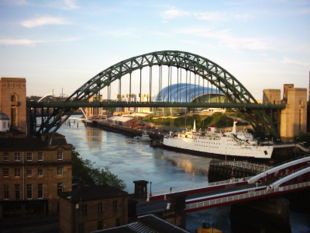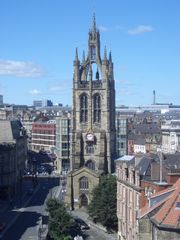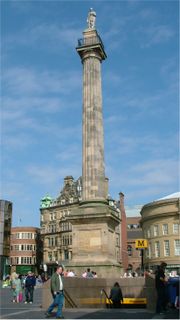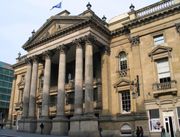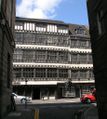Newcastle upon Tyne
2007 Schools Wikipedia Selection. Related subjects: Geography of Great Britain
| City of Newcastle upon Tyne | |
|---|---|
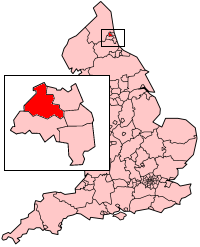 |
|
| Geography | |
| Status: | Metropolitan borough, City (1882) |
| Region: | North East England |
| Ceremonial County: | Tyne and Wear |
| Traditional County: | Northumberland |
| Area: - Total |
Ranked 229th 113.44 km² |
| Admin. HQ: | Newcastle upon Tyne |
| ONS code: | 00CJ |
| Demographics | |
| Population: - Total (2005 est.) - Density |
Ranked 28th 276,400 2,437 / km² |
| Ethnicity: | 93.1% White 4.4% S.Asian |
| Politics | |
 Newcastle upon Tyne City Council http://www.newcastle.gov.uk/ |
|
| Leadership: | Leader & Cabinet |
| Executive: | Liberal Democrats |
| MPs: | Nick Brown, David Clelland, Jim Cousins, Doug Henderson |
Newcastle upon Tyne, often shortened to Newcastle, is a city and metropolitan borough of Tyne and Wear situated on the north bank of the River Tyne, in North East England. The city was founded in Roman times under the name Pons Aelius, with the current name being adopted from 1080 onwards. It was once the county town of Northumberland .
The city is the 20th most populous in England and the Tyneside conurbation, of which Newcastle forms part, is the 5th most populous conurbation in England. Newcastle is a member of the English Core Cities Group.
Technically, people from Newcastle are Novocastrians (a Latin term which can equally be applied to residents of any place called Newcastle), although the term Geordie is now more commonly used.
The name of the city is pronounced new-CASS-el in the north of England, and NEW-cah-sel in the south.
History
Early development
Newcastle, known at the time as "Pons Aelius" was founded by the Roman Emperor Hadrian, whose Wall is still visible in parts of Newcastle, particularly along the West Road. The course of the "Roman Wall" can also be traced eastwards to Wallsend ( Segedunum).
After the Roman withdrawal from Britain, Newcastle became part of the powerful Anglo-Saxon kingdom of Northumbria and was known throughout this period as Monkchester. After a series of conflicts with the Danes and the devastation north of the River Tyne inflicted by Odo after the 1080 rebellion against the Normans, Monkchester was all but destroyed. Because of its strategic position, Robert Curthose, son of William the Conqueror, erected a wooden castle there in 1080 and the town was henceforth known as Novum Castellum or New Castle.
Throughout the Middle Ages, Newcastle was England's northern fortress. A 25ft high stone wall was built around the town to defend it from invaders during the Border war against Scotland. The Scots king William the Lion was imprisoned in Newcastle in 1174, and Edward I brought the Stone of Scone and William Wallace south through the town. Newcastle was successfully defended against the Scots three times during the 14th century and around this time became a county corporate.
King Charles bestowed upon Newcastle the East of England coal trading rights. This monopoly helped Newcastle prosper, but it had its impact on the growth of near-neighbours Gateshead and Sunderland, causing a North of Tyne/South of Tyne and a Tyne-Wear rivalry that still exists. During the English Civil War, Newcastle supported the king and in 1644 was stormed ('with roaring drummes') by Cromwell's Scots allies, based in pro-Parliament Sunderland. The grateful King bestowed the motto "Fortiter Defendit Triumphans" ("Triumphing by a brave defence") upon the town. Ironically, Charles was imprisoned in Newcastle by the Scots in 1646-7.
In the 18th century, Newcastle was the country's largest print centre after London, Oxford and Cambridge, and the Literary and Philosophical Society of 1793, with its erudite debates and large stock of books in several languages predated the London Library by half a century. Newcastle also became the greatest glass producer in the world. Newcastle's development as a major city, however, owed most to its central role in the export of coal. The phrase taking coals to Newcastle was first recorded in 1538. In the nineteenth century, shipbuilding and heavy engineering were central to the city's prosperity; and the city was a powerhouse of the Industrial Revolution. Innovation in Newcastle and surrounding areas included the development of Safety lamps, Stephenson's Rocket, Lord Armstrong's artillery, Joseph Swan's electric light bulbs, and Charles Parsons' invention of the steam turbine, which led to the revolution of marine propulsion and the production of cheap electricity.
Heavy industries in Newcastle declined in the second half of the twentieth century; office and retail employment are now the city's staples.
Urban development
Notable architecture
The city has an extensive neoclassical centre, largely developed in the 1830s by Richard Grainger and John Dobson, and recently extensively restored. Grey Street, which curves down from Grey's Monument towards the valley of the River Tyne, was voted as England's finest street in 2005 in a survey of BBC Radio 4 listeners. A portion of Grainger Town was demolished in the 1960s to make way for the Eldon Square shopping centre, including all but one side of the original Eldon Square itself.
Parks and open space
Immediately to the northwest of the city centre is Leazes Park, established in 1873 after a petition by 3,000 working men of the city for "ready access to some open ground for the purpose of health and recreation". Just outside one corner of this is St James' Park, the stadium home of Newcastle United F.C. which dominates the view of the city from the south.
Another green space in Newcastle is the vast Town Moor, lying immediately north of the city centre. It is larger than Hyde Park and Hampstead Heath put together and the freemen of the city have the right to graze cattle on it. Unlike other cities where similar rights exist, they often take advantage of this, leading to the somewhat bizarre sight of cattle grazing within yards of the city's town hall or "Civic Centre". The right incidentally extends to the pitch of St James' Park, Newcastle United Football Club's ground, though this is not exercised. Honorary freemen include Bob Geldof, Nelson Mandela, Alan Shearer and the Royal Shakespeare Company. The Hoppings funfair, said to be the largest travelling fair in Europe, is held here annually in June.
The wooded gorge of the Ouseburn in the east of the city is known as Jesmond Dene and forms another popular recreation area, linked by Armstrong Park and Heaton Park to the Ouseburn Valley, where the river finally reaches the River Tyne.
Recent developments
The development of the city in the 1960s and 1970s saw the demoliton of part of Graingertown as a prelude to the modernist rebuilding initiatives of T. Dan Smith, the leader of Newcastle City Council. A corruption scandal was uncovered involving Smith and John Poulson, a property developer, and both were jailed. Echoes of the scandal were revisited in the late 1990s in the BBC TV mini-series, Our Friends in the North.
The Tyne gorge between Newcastle (on the north Bank) and Gateshead (an administratively separate borough) on the south, is famous for a series of dramatic bridges, including the Tyne Bridge of 1928 and Robert Stephenson's High Level Bridge of 1849, the first road/rail bridge in the world. Large-scale regeneration has replaced former shipping premises with imposing new office developments; an innovative tilting bridge, the Gateshead Millennium Bridge was commissioned by Gateshead and has integrated the older Newcastle Quayside more closely with major cultural developments in Gateshead, including the BALTIC Centre for Contemporary Art and the Norman Foster-designed Sage music centre. NewcastleGateshead Quayside is now a thriving, cosmopolitan area with an abundance of bars, restaurants and public spaces. As a tourist promotion, Newcastle and Gateshead have linked together under the banner "NewcastleGateshead", but otherwise remain separate.
Notable Newcastle housing developments include Ralph Erskine's the Byker Wall designed in the 1960s and now Grade II-listed. It is on UNESCO's list of outstanding 20th century buildings.
Newcastle's thriving Chinatown lies in the northwest of Grainger Town, centered on Stowell Street. A new Chinese Arch, or paifang, providing a landmark entrance, was handed over to the City with a ceremony in 2005.
Science city
The UK's first Biotechnology Village, the " Centre for Life" is located in the City Centre close to the Central Station. The village is the first step in the City Council's plans to transform Newcastle into a Science city .
Geography
Newcastle is situated in the North East of England, in the ceremonial county of Tyne and Wear. The city itself is located on the northern bank of the Tyne Valley at a latitude of 54.97°N and a longitude of 1.62°W.
The geology of the area is most famous for its large deposits of coal. Whilst the local bedrock consists mainly of carboniferous rocks, millstone grit and oolite are also present.
Climate
The climate in Newcastle is temperate, although significantly warmer than some other locations at a similar latitude due to the warming influence of the Gulf Stream (via the North Atlantic Drift). Being in the rain shadow of the North Pennines, it is among the driest cities in the UK. The prevailing winds are south-westerly due to the North Atlantic Current.
Law and government
Newcastle is governed using the leader and cabinet system, and the executive is currently Liberal Democrat, as they have 48 councillors against the Labour Party's 30. No other parties hold seats on the city's council.
Administrative districts
Newcastle has 26 electoral wards.
|
|
Demographics
Population
According to the UK Government's 2001 census , the unitary authority of Newcastle has a population of around 259,500. However, the metropolitan boroughs of North Tyneside (population c.190,000), South Tyneside (population c. 150,000) and Gateshead (population c.200,000) are also part of Newcastle's conurbation, giving the Newcastle-Gateshead metropolitan area a population of 799,000. According to the same statistics, the average age of people living in Newcastle is 37.8 (the national average being 38.6). 93.1% of the population are of White ethnic background (the national average being 91.3%). Other ethnic groups in Newcastle, in order of population size, are Pakistani at 1.9% and Indians at 1.2%. There are also small but significant Chinese and Jewish populations.
Religion
The city is largely Christian at 70.6%, with Islam (3.6%) the only other significantly practised religion. A large number (16%) have no religion.
Newcastle has two cathedrals, the Anglican St. Nicholas, with its elegant lantern tower of 1474, and the Roman Catholic St. Mary's, designed by Augustus Welby Pugin. Both cathedrals began their lives as parish churches. St Mary's became a cathedral in 1850 and St Nicholas' in 1882. Cardinal Basil Hume, Archbishop of Westminster ( 1976- 1999) was born in the city in 1923. A statue of the Cardinal, (unveiled by the Queen in 2002), stands outside St Mary's Cathedral in a memorial garden dedicated to the religious leader.
Health
Of the population, 11.8% described themselves as "not healthy" in the 12 months before the 2001 census, compared to a national average of 9.2%. Additionally, 21.6% of the inhabitants said they had a long-term illness, as against 18.2% nationally.
Newcastle Hospitals Trust One has one of the lowest mortality rates in the country and is ranked second in the country for confidence in doctors. Staffing levels are high - in the top 70 in England for doctors and the top ten for nurses. Newcastle has three large teaching hospitals: the Royal Victoria Infirmary, whose organ donor system has been featured on television; the Newcastle General Hospital and the Freeman Hospital, which amongst other things, performs transplant surgery.
Transport and infrastructure
Air
Located on the northern outskirts of the city, near Ponteland, is Newcastle Airport, which has recently been rebranded as Newcastle International. The airport currently handles over five million passengers per year, and is one of the fastest growing airports in the UK. As of 2006, more than 80 destinations are available world-wide. It is currently the UK's ninth biggest airport. A large scale development in unused land near the edge of the city close to the airport should help growth further. The development is called Newcastle Great Park. If Newcastle's super casino bid is a success then that should also contribute to growth.
A recent article revealed that the airport hoped to achieve 10 million passangers by 2016, and 15 million by 2030.
Bus
Newcastle and the surrounding area has an extensive bus network that is coordinated by Nexus, the Tyne and Wear Passenger Transport Executive. Buses are operated mainly by Go North East, Arriva and Stagecoach North East.
Quayside Transit (operated by Stagecoach Newcastle), a £5m bus scheme using ultra low emission hybrid diesel-electric vehicles was launched in July 2005.
Metro
In 1904, the North Eastern Railway built an electric suburban railway serving both banks of the Tyne, and the northern suburbs. The system was transformed into the Tyne and Wear Metro which opened in 1980, and extends as far as Newcastle Airport, Tynemouth and South Hylton in Sunderland. The system is one of only four underground systems in the United Kingdom.
The Metro is usually described as Britain's first modern light rail system. It carries approximately 40 million passenger journeys per year, and is co-ordinated by the Tyne and Wear Passenger Transport Executive. It is the second biggest metropolitan train system in the UK.
Rail
Newcastle is a principal stop on the East Coast Main Line and Cross Country Route. The central station was the first covered railway station in the world and was much copied across the UK. It has a fine neoclassical frontage originally designed by the architect John Dobson and was constructed in collaboration with Robert Stephenson. The station was opened in 1850 by Queen Victoria, with the first services being operated by the North Eastern Railway company.
Today, train operator GNER provides a half-hourly frequency of trains to London, with a journey time of a little less than three hours. Virgin Trains, Northern Rail and Transpennine Express operate regular services to many other destinations including Birmingham, Bristol, Cardiff, Carlisle, Edinburgh, Glasgow, Leeds, Liverpool and Sheffield.
The city's other mainline station, Manors, is situated to the north east of the city centre.
Road
Major roads in the area include:
- A1 (Gateshead Newcastle western-bypass), stretching north/south between London and Edinburgh
- A19 heading south past Sunderland and Middlesbrough to York and Doncaster
- A69 heading west to Carlisle
- A167 the old Great North Road heading south to Gateshead, Chester-le-Street, Durham and Darlington
- A1058 "coast road" which runs from Jesmond to the east coast between Tynemouth and Cullercoats
Many of these designations are recent - upon completion of the western bypass, and its designation as the new line of the A1, the roads between this and the former line through the Tyne Tunnel were renumbered wholesale, with many city centre roads changing from a 6-prefix to their present 1-prefix numbers.
Sea
Newcastle also has access to an international Ferry Terminal, located at nearby North Shields, offering services to destinations including Amsterdam, Kristiansand, Gothenburg, Stavanger, Haugesund and Bergen.
The ferry to Gothenburg, Sweden (currently run by the Danish company DFDS Seaways), will cease at the end of October 2006. The company cited high fuel prices and new competition from low-cost air services, especially Ryanair (which now flies to Glasgow Prestwick and London Stansted from Gothenburg City Airport), as being the cause. DFDS Seaways' sister company, DFDS Tor Line, will continue to run scheduled freight ships between Gothenburg and several English ports, including Newcastle, and these have limited capacity for passengers, but not private vehicles. It is unclear if the Newcastle-Kristiansand route will continue.
Sport
The City has a strong sporting tradition, being home to Premiership football team Newcastle United, and Guinness Premiership rugby union side Newcastle Falcons, for whom England player Jonny Wilkinson features.
The city's Metro Radio Arena is home to Newcastle Vipers ice hockey team, and Newcastle Eagles basketball team. The City's Speedway team Newcastle Diamonds are based at Brough Park in Byker, a venue that is also home to greyhound racing. The greatest Speedway rider of all time, Ivan Mauger, who hailed from New Zealand was World Champion six times and rode for the Diamonds in the 1960's. Newcastle Racecourse at High Gosforth Park holds regular meets, including the prestigious race for the Northumberland Plate, first run in 1838, which takes place in June each year.
Newcastle also hosts the start of the annual BUPA Great North Run, the world's largest half- marathon in which participants famously race over the Tyne Bridge into Gateshead and then towards the finish line 13.1 miles away on the coast at neighbouring South Shields. Another famous athletic event is the 10k Blaydon Race, which has taken place annually in nearby Blaydon, since 1981, on June 9 to commemorate the celebrated Blaydon Races horse races.
Education
The city has two universities, Newcastle University which earned the coveted Sunday Times University of the Year award in 2000 and the newer Northumbria University that was established in 1992 and was voted 'Best New University' by The Times Good University Guide 2005.
There are eleven LEA-funded 11 to 18 schools and seven independent schools with sixth forms in Newcastle. The largest independent school is the Royal Grammar School located in Jesmond. There are a number of successful state schools, including Gosforth High School, Heaton Manor, St Cuthbert's, Kenton School and Sacred Heart. Newcastle College is the largest general further education college in the North East, and there are two smaller colleges in the Newcastle area. Newcastle College is also one of the select few beacon colleges in the United Kingdom.
Some 45% of Newcastle's school pupils live in wards which are amongst the 10% most deprived in England.
Culture
Dialect
The Geordie dialect is more than an alternative pronunciation of English. There is a large amount of vocabulary that does not exist in other parts of England, and words often have different meanings. Much of the dialect can be traced back to the Old Norse and Old English languages and certain words are very similar to their equivalents in modern Swedish.
Entertainment
Nightlife
Newcastle has a reputation for being a fun-loving city with many bars, restaurants and nightclubs. More recently, Newcastle has become popular as a destination for Stag and Hen parties. Newcastle was also placed 7th in the 'Worldwide best places for a Night-Out', in 2000. 'The Rough Guide to Britain' has placed the nightlife in Newcastle upon Tyne as a top attraction in Great Britain for tourists.
There are notable concentrations of pubs, bars and nightclubs around the Bigg Market, and the Quayside area areas of the city centre. Other popular areas for nightlife are Collingwood Street, Neville Street, the Central Station area and Osborne Road in the Jesmond area of the city. In recent years "The Gate" has opening in the city centre, a new indoor complex consisting of bars, upmarket clubs, restaurants and a 12-screen Empire multiplex cinema.
Focused on the Times Square area near the Centre for Life, the "Pink Triangle" is the centre of Newcastle's gay scene and hosts approximately many bars and pubs and two clubs, Powerhouse and The Loft. The community has seen much expansion in the past five years, with further growth planned in the future. The Pink Triangle was a planned development promoted by the Regional Development Agency.
The city is also home to several historic and traditional pubs, including The Crown Posada, The Cooperage, The Bodega and The Bacchus.
Theatre
A growth in theatre culture has taken place in recent years, centred on the impressive Theatre Royal on Grey Street, which for over 25 years has hosted a season of performances from the Royal Shakespeare Company. The Theatre Royal is currently closed for refurbishment and is set to reopen in October 2006 in time for the travelling West End musical, Grease and the annual RSC season. Other theatres in the City include the Tyne Opera House, the Northern Stage, the Live Theatre, the People's Theatre and the Gulbenkian Studio. There are several other venues in and around Newcastle, such as Newcastle City Hall, Newcastle Arena and The Sage Gateshead.
Festivals and fairs
The Hoppings, reputedly the largest travelling fair in Europe, takes place on Newcastle Town Moor every June. The event had its origins in the Temperance movement during the early 1880s and coincides with the annual race week at High Gosforth Park.
A new music festival, the Hi Fi Festival took place in May 2006, at Matfen on the outskirts of the City. May also sees Newcastle and Gateshead host the Orange Evolution, which culminates with the Freevolution free music festival held on the Newcastle and Gateshead Quaysides over the Spring Bank Holiday, with performances from well known and up and coming acts from the world of Rock, Indie and Dance Music. Surrounding Tyneside has many festivals, including MOTFest (The Mouth Of Tyne Festival) held at Tynemouth, a coastal village 8 miles East of Newcastle.
Shopping
There are several major shopping areas in Newcastle city centre. The largest of these is the Eldon Square shopping centre, which incorporates the largest Fenwick department store in the UK and a John Lewis store (formerly known as Bainbridge), which is often cited as the first department store in the UK. Eldon Square is currently undergoing a full redevelopment which will include a new bus station, replacing the old underground bus station and redeveloping the fascia of the centre that faces Grainger Town to allow the 60's concrete to be replaced by more forgiving materials to accommodate its architectural surroundings. As part of the redevelopment the 1970's Green Market will be closed down in early 2007 and rebuilt.
The main shopping street in the city is Northumberland Street. In a 2004 report, it was ranked as the most expensive shopping road in the UK for rent, outside London. Other shopping centres in Newcastle include the relatively modern Eldon Garden and Monument Mall complexes, the Newgate Centre, Central Arcade and the traditional Grainger Market. The largest suburban shopping areas are Gosforth and Byker. The largest indoor shopping centre in Europe, The MetroCentre in Gateshead is also nearby.
Out of town, just a few miles to the East lie the coastal resorts of Tynemouth, Whitley Bay and Cullercoats which offer a great selection of shopping attractions. The up and coming Saville Quarter of North Shields, just 15 minutes from Newcastle City Centre is home to the North Shields Fish Quay with its eclectic mix of pubs and restaurants. Relax after shopping with a pint and a bar meal at the ubiquitous Magnesia Bank which is just around the corner, or the upmarket Saville Exchange across the road. The attractions described here can also be easily reached by Metro, bus, car, the Shields Ferry that runs between North and South Shields and the DFDS seaways ferry at the North Shields terminal, adjacent to the Royal Quays retail outlet which is also well worth a visit.
Famous residents
Engineer and industrialist Lord Armstrong, Catholic leader Cardinal Basil Hume, musician Sting, comedian Rowan Atkinson, entertainers Ant and Dec, and international footballers Paul Gascoigne, Peter Beardsley, Chris Waddle and Alan Shearer are a few of the many famous people born in or associated with Newcastle. For a full list, see List of famous residents of Newcastle upon Tyne.
Museums and places of interest
| Key | |
| |
National Trust |
| |
English Heritage |
| |
Forestry Commission |
| Country Park | |
| Accessible open space | |
| Museums (free/not free) | |
| Heritage railway | |
| Historic House | |
Twin cities
|
|
Foreign consulates
The following countries have consular offices in Newcastle:
 The Royal Norwegian Consulate: 14 Grey Street, NE1 6AE
The Royal Norwegian Consulate: 14 Grey Street, NE1 6AE Honorary Consulate of the Netherlands : The Cube, Barrack Road, NE4 6DB
Honorary Consulate of the Netherlands : The Cube, Barrack Road, NE4 6DB Honorary Consulate of Sweden: 2 Osborne Road, Jesmond, NE2 2AA
Honorary Consulate of Sweden: 2 Osborne Road, Jesmond, NE2 2AA Honorary Consulate of Italy: 63 High Bridge, NE1 1DU
Honorary Consulate of Italy: 63 High Bridge, NE1 1DU
